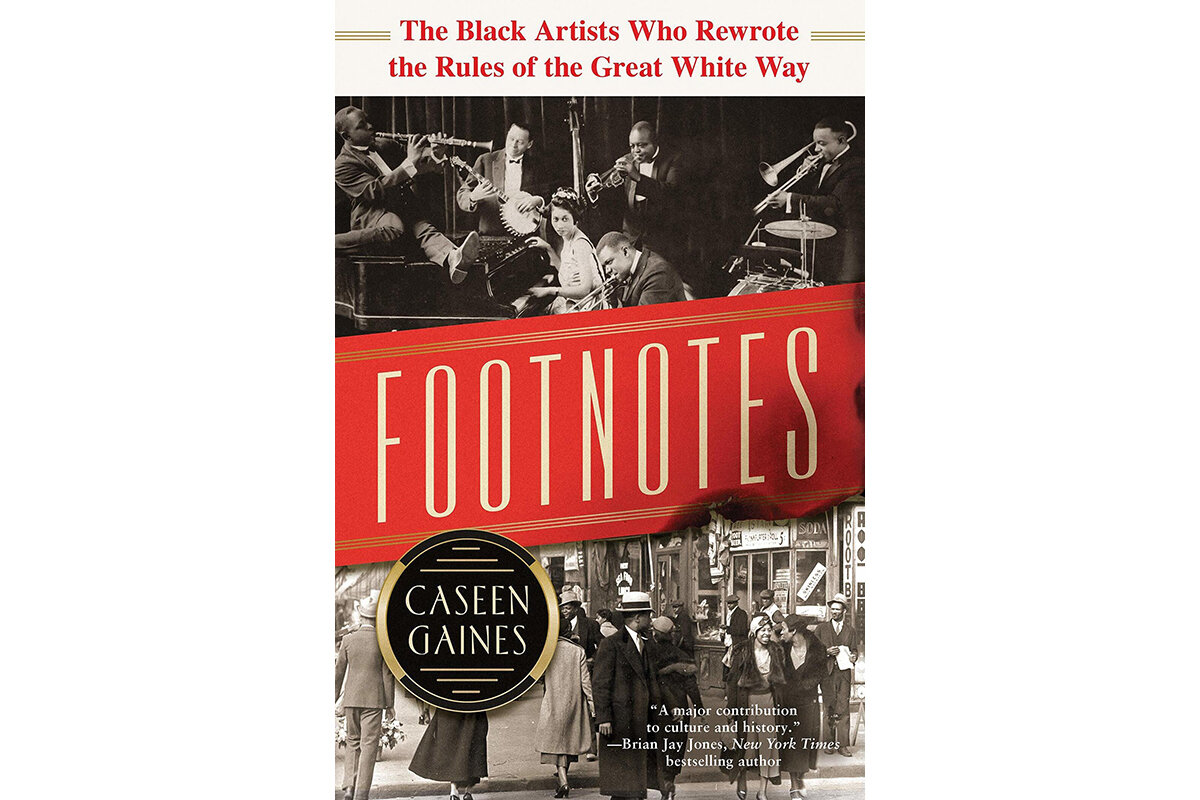Before ‘The Wiz’ and ‘Dreamgirls,’ there was ‘Shuffle Along’
Loading...
Cultural historian Caseen Gaines dives into one of the most momentous stage productions in the history of Black theater in “Footnotes: The Black Artists Who Rewrote the Rules of the Great White Way.”
The 1921 Broadway musical “Shuffle Along” told the satirical story of a small-town mayoral race, but more important than its plot was the fact that it boasted an all-Black cast, and its music, script, and song lyrics were written by Black artists.
Mr. Gaines’ book argues that “Shuffle Along” presented a far richer and subtler vision of Black life than any other Broadway production before it. But the show also included blackface and racial stereotypes, making it difficult to revive; because of this, it’s been largely forgotten. (It was, however, the subject of a 2016 Tony Award-nominated “making-of musical,” which was also titled “Shuffle Along.”)
Why We Wrote This
Should a musical with racial stereotypes be permanently shelved? What if it had Black creators? “Shuffle Along” from 1921 included blackface and caricature, but a Black historian argues there is “immense value in remembering that this show existed.”
Mr. Gaines spoke with the Monitor about his decision to revisit “Shuffle Along.”
What drew you to write about a musical that no one wants to perform any longer?
In looking at the story of composer Eubie Blake, lyricist Noble Sissle, and writer-performers Flournoy Miller and Aubrey Lyles, I was reminded of artists like Hattie McDaniel, the first Black woman to win an Academy Award; [comedian] Stepin Fetchit; and William “Billie” Thomas Jr., who’s better known as Buckwheat from the “Our Gang” comedies. I was thinking about these people who were really quite progressive and opened doors in a lot of ways, particularly in the early part of the 20th century. They have been locked in the vault because their portrayals have been viewed as problematic, stereotypical, and degrading to Black people.
While I certainly understand that perspective, I also think that something becomes lost when Black folks don’t have the opportunity to see themselves
in these spaces that are often thought of as primarily white spaces, as theater still is today. But also I think something is lost for white folks as well, who don’t have to, as [playwright] August Wilson said, face what so many Black people have had to endure in this country.
So we shouldn’t neglect the fact that these problematic productions existed?
Absolutely, and I would even go a step further and say that there are all sorts of works of art that are problematic, and yet they are still remembered and revered. Particularly in theater, there are shows that are sexist, homophobic, transphobic, and xenophobic that are performed in high schools and community theaters and revived on Broadway with frequency, and yet we don’t cast those aside.
It’s a complicated history. Certainly I wouldn’t go as far as saying that I think that the 1921 “Shuffle Along” should be revived on Broadway in its original iteration, but I certainly do feel there is a double standard, and I think that there is value – immense value – in remembering that this show existed.
Was there anything like a precedent to “Shuffle Along” on Broadway?
There were a number of predecessors to “Shuffle Along,” the most significant being by the duo of [vaudevillians] Williams and Walker. I would make the distinction that while there were shows that had played on Broadway, as in on the street of Broadway, none of these shows actually commanded Broadway ticket prices. They were novelties; they were kind of expanded vaudeville shows but they did get rave reviews.
How different was “Shuffle Along” from the shows that preceded it in terms of the way it presented Black people?
A few days before “Shuffle Along” opened at the 63rd Street Theatre, the four creators ran into the editor of Variety, and he [essentially] said, “Best of luck to you, but your show is dead in the water because white people, and white women in particular, will never pay Broadway prices to see Black women onstage.” It wasn’t just seeing Black women onstage, but it was seeing Black women onstage outside of the well-established, stereotypical roles that were born out of minstrelsy.
While [“Shuffle Along”] did have Black actors in blackface in terms of the comedians, all of the women were presented as real people. The very notion that there would be a Black man and a Black woman onstage who would convey love for each other, and not have that love played for humor but played for sentimentality, the producers of the show got threats [basically] saying, “You should be careful that the white folks in the audience don’t riot at the sight of it.”
The show had an overwhelmingly favorable response when it premiered, among both Black and white audiences. Were there dissenting voices in the Black community who felt “Shuffle Along” didn’t go far enough in breaking stereotypes?
There were. One of the most significant is probably [Harlem Renaissance writer] Claude McKay, who really enjoyed “Shuffle Along” but thought that there was such a missed opportunity in not going far enough in its representation of Black women. Nearly all of the women who were in the cast were of a lighter skin complexion.
[McKay] was quite vocal in saying what a shame it is that this show is so good, and such a success, and yet it is not exposing white audiences to the full range of the beauty of Black women.
“Shuffle Along” anticipated later Black Broadway productions such as “The Wiz” and “Dreamgirls,” but did the show open doors for Black artists in the shorter term?
The most undeniable achievement of “Shuffle Along” was that it burst the door wide open for representation on Broadway. The 2016 Broadway season was celebrated for being the most diverse in Broadway history ... but there were more Black folks working on Broadway in the mid-1920s than there are today.
While the entertainment industry worked to close some of those doors over time, there was a brief period where the doors were completely blown off the hinges.







